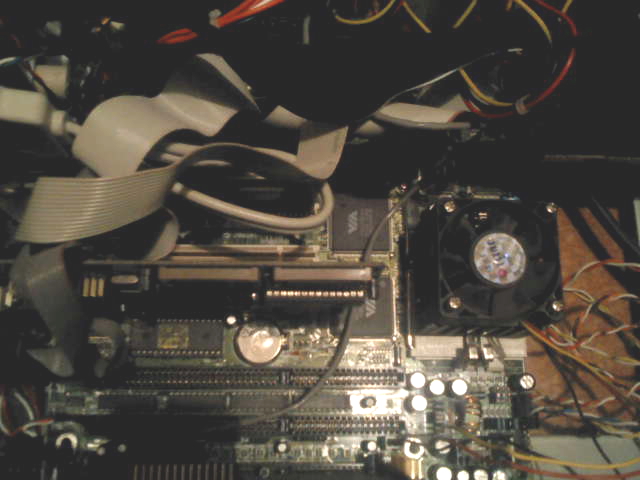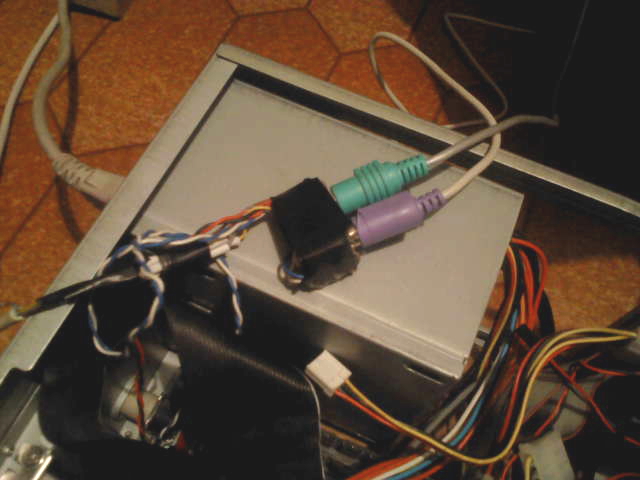Dances with a tambourine on New Year's Eve or the second life of old cars
Good day, dear. I’ll tell you today as part of the topic of the article how I spent New Year’s Eve. Not only I will tell, but also show pictures. It was a very exciting action. Well, it all started like that. After installing and configuring the home mini-server, my mother wanted a computer for herself. Like, I'm worse. I want to read information on the Internet, type texts and the like. Thought I thought and thought up.
Once, a long time ago I read one article about thin clients. What can I set up an old machine - Intel i486, pentium I, II and the like for normal operation: watching videos, surfing the Internet and more. It sounds fantastic. But it's true. You can do such shamanism. For this, you need a powerful server and client (in my case, it turned out to be Intel Pentium MMX 200 RAM 64Mb 2MB Video and without HDD).

In general, it was before the new year. This design would be a good New Year's gift to mom. I decided for a long time not to postpone it. For the computer it was necessary to buy something nonsense: a new keyboard and mouse. Do not laugh, but the keyboards are no longer available for the AT-case. On rare boards, this is a DIN-5 connector. It looks like a plug from an old tape recorder. The mouse can be connected to ps / 2 there, on the motherboard there are special pins for this.
And I bought a keyboard ps / 2 too. And managed to make her friends with the AT-corps. To do this, I had to bungle the adapter. I took a cord from an old broken AT keyboard, sawed off the ps / 2 connector from a broken motherboard. After half an hour, the following happened.

All! Now you can use an optical mouse and a new keyboard with an old computer. Parts were all in place. It remained to perform the sacrament of setting up the server for this miracle. For this junk to work, all that was needed was to install the so-called LTSP server. Those who wish can read about this project on the wikipedia page en.wikipedia.org/wiki/LTSP The
operating system on my server is of course GNU / Debian Linux. Seventh version (stable release). Let's go, as Yuri Gagarin said. At first it was necessary to bring to mind the server side. Using remote access to the machine via ssh, I installed the packages necessary for the LTSP miracle to work.
All the necessary packages were pulled up, including a DHCP server and TFTP. Yes, you also have to configure them in one. Out of the box, nothing works. It is necessary to finish this file with a file to condition. And now the promised dances with tambourines have gone. This is a common thing with the "red-eyed". These dances lasted all New Year's Eve. So I was not bored. I didn’t even watch TV for the whole evening.
The good news was waiting for me. TFTP does not need to be configured, it wound up independently. Basic settings need to be done for DHCP. It will distribute network addresses to machines and thanks to it will be subsequent download over the network via TFTP. A configuration file was found at /etc/ltsp/dhcpd.conf. My file looks like this:
A couple more changes needed to be done in the file / etc / default / isc-dhcp-server
Everything should be clear here. We indicate the location of the configuration file for the DHCP server, listen to requests from the local network on the eht1 interface. After these simple steps you need to restart the dhcp server
It remains to configure the import of the ltsp server file system. Add a line to the / etc / exports file
You can create a working environment for customers.
This is a procurement system into which thin clients will be loaded over the network. To configure this system, you need to enter the chroot environment:
And then it went and went ... apt-get install and the necessary packages.
Restart the nfs server and you're done.
Now the matter is left to the small. You need to prepare a client computer to boot over the network. This will help the following site rom-o-matic.net/gpxe/gpxe-1.0.1/contrib/rom-o-matic . Prepare the image for download. I chose an iso image. I wrote it to the disc and now I load it using the CD / DVD drive.
And ... oh, a miracle! On an old computer you can see the following. Let me remind you for those who forgot. It does not have a hard disk and only 64 (sixty four) megabytes of RAM. Not to be confused with gigabytes.

These are adventures on New Year's Eve) The computer is ready and a brand new monitor is waiting. Not a bad combination of rare technology with new technologies. This, of course, is not a Google Nexsus tablet ... but still. Good luck in the new year and in configuring GNU / Linux. See you on the pages of my blog. Leave your thoughts, comments and tips.
Once, a long time ago I read one article about thin clients. What can I set up an old machine - Intel i486, pentium I, II and the like for normal operation: watching videos, surfing the Internet and more. It sounds fantastic. But it's true. You can do such shamanism. For this, you need a powerful server and client (in my case, it turned out to be Intel Pentium MMX 200 RAM 64Mb 2MB Video and without HDD).

In general, it was before the new year. This design would be a good New Year's gift to mom. I decided for a long time not to postpone it. For the computer it was necessary to buy something nonsense: a new keyboard and mouse. Do not laugh, but the keyboards are no longer available for the AT-case. On rare boards, this is a DIN-5 connector. It looks like a plug from an old tape recorder. The mouse can be connected to ps / 2 there, on the motherboard there are special pins for this.
And I bought a keyboard ps / 2 too. And managed to make her friends with the AT-corps. To do this, I had to bungle the adapter. I took a cord from an old broken AT keyboard, sawed off the ps / 2 connector from a broken motherboard. After half an hour, the following happened.

All! Now you can use an optical mouse and a new keyboard with an old computer. Parts were all in place. It remained to perform the sacrament of setting up the server for this miracle. For this junk to work, all that was needed was to install the so-called LTSP server. Those who wish can read about this project on the wikipedia page en.wikipedia.org/wiki/LTSP The
operating system on my server is of course GNU / Debian Linux. Seventh version (stable release). Let's go, as Yuri Gagarin said. At first it was necessary to bring to mind the server side. Using remote access to the machine via ssh, I installed the packages necessary for the LTSP miracle to work.
apt-get install ltsp-server-standalone
All the necessary packages were pulled up, including a DHCP server and TFTP. Yes, you also have to configure them in one. Out of the box, nothing works. It is necessary to finish this file with a file to condition. And now the promised dances with tambourines have gone. This is a common thing with the "red-eyed". These dances lasted all New Year's Eve. So I was not bored. I didn’t even watch TV for the whole evening.
The good news was waiting for me. TFTP does not need to be configured, it wound up independently. Basic settings need to be done for DHCP. It will distribute network addresses to machines and thanks to it will be subsequent download over the network via TFTP. A configuration file was found at /etc/ltsp/dhcpd.conf. My file looks like this:
authoritative;
subnet 192.168.0.0 netmask 255.255.255.0 {
range 192.168.0.1 192.168.0.250; # диапазон адресов для сетевой загрузки
option domain-name "paulo737.pp.ua"; # доменное имя моего сервера
option log-servers 192.168.0.1; # ip сервера для логирования
option domain-name-servers 192.168.0.1; # сервер ДНС
option broadcast-address 192.168.0.255; # широковещательный адрес
option routers 192.168.0.1; # настройка маршрутизации
next-server 192.168.0.1;
# get-lease-hostnames true;
option subnet-mask 255.255.255.0; # маска подсети
option root-path "/home/ltsp/i386"; # путь к корню LTSP-сервера
filename "/ltsp/i386/pxelinux.0"; # файл для загрузки по сети
}
A couple more changes needed to be done in the file / etc / default / isc-dhcp-server
DHCP_CONF=/etc/ltsp/dhcpd.conf
INTERFACES="eth1"
Everything should be clear here. We indicate the location of the configuration file for the DHCP server, listen to requests from the local network on the eht1 interface. After these simple steps you need to restart the dhcp server
/etc/init.d/isc-dhcp-server restart
It remains to configure the import of the ltsp server file system. Add a line to the / etc / exports file
/home/ltsp/i386 *(ro,no_root_squash,async)
You can create a working environment for customers.
ltsp-build-client --base /home/ltsp
This is a procurement system into which thin clients will be loaded over the network. To configure this system, you need to enter the chroot environment:
ltsp-chroot
And then it went and went ... apt-get install and the necessary packages.
Restart the nfs server and you're done.
Now the matter is left to the small. You need to prepare a client computer to boot over the network. This will help the following site rom-o-matic.net/gpxe/gpxe-1.0.1/contrib/rom-o-matic . Prepare the image for download. I chose an iso image. I wrote it to the disc and now I load it using the CD / DVD drive.
And ... oh, a miracle! On an old computer you can see the following. Let me remind you for those who forgot. It does not have a hard disk and only 64 (sixty four) megabytes of RAM. Not to be confused with gigabytes.

These are adventures on New Year's Eve) The computer is ready and a brand new monitor is waiting. Not a bad combination of rare technology with new technologies. This, of course, is not a Google Nexsus tablet ... but still. Good luck in the new year and in configuring GNU / Linux. See you on the pages of my blog. Leave your thoughts, comments and tips.
